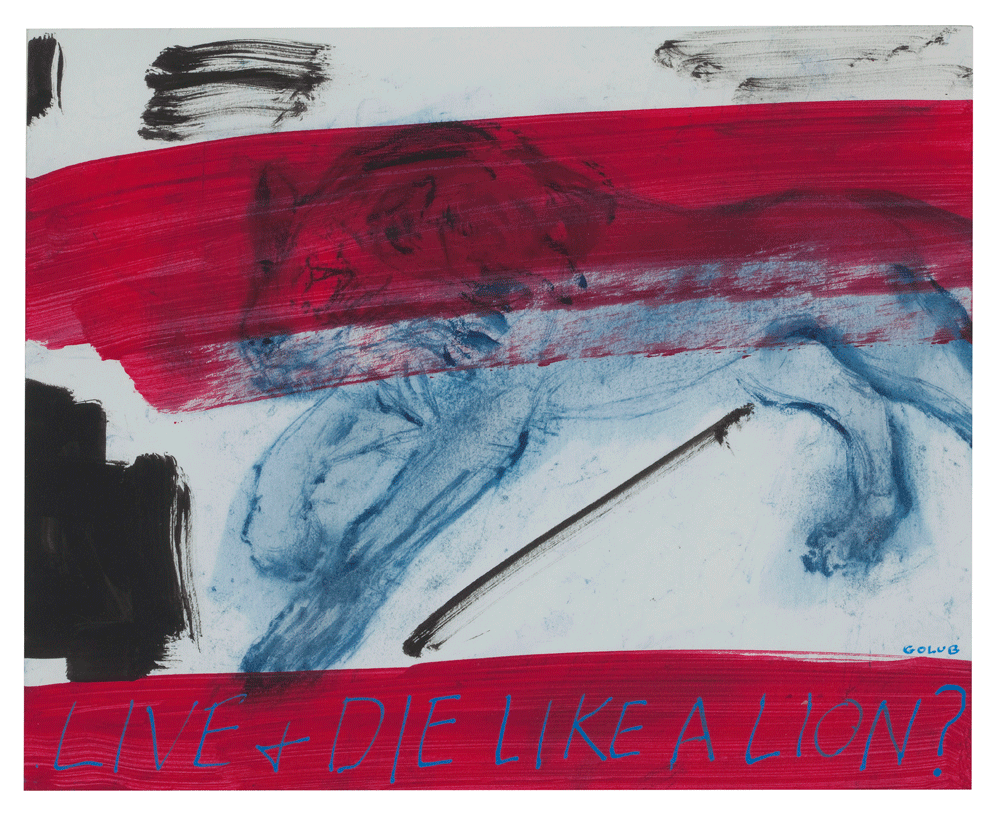Leon Golub
The Drawing Center, New York, USA
The Drawing Center, New York, USA
The introductory wall text to this striking exhibition, ‘Live & Die Like a Lion?’, noted that Leon Golub is ‘most often celebrated as a painter’. But this classification elides a vital dimension of the artist’s working process: for several decades he scraped rather than merely painted. Using a meat cleaver just as often as a brush, Golub literally hewed acrylic onto (and into) his raw linens. Critics have often noted how this method recalls the very violence of the acts – extrajudicial violence and torture chief among them – so often depicted in Golub’s work. The nervous, blurry surfaces of his paintings also evince their untraceable locales, their potential occurrence at once everywhere and nowhere in particular. How, then, does drawing – a generally less athletic and more precise procedure – figure in Golub’s oeuvre?

Drawing in Golub’s hand eschews the fastidiousness of line for a more agitated, painterly application; figure and ground are often rendered in the same hue and texture, collapsing any clear boundaries between them. In this regard, Golub’s drawings (whether in oil stick, chalk, ink or a mix thereof) often strongly resemble his paintings. Conversely, the sole painting in the exhibition was, to all intents and purposes, a drawing: Untitled (2001) depicts a pair of noble lionesses, delineated in wisps of white and grey chalk and crayon against a large, unprimed canvas. Their bodies transparent to their background, the animals appear as tawny as the tooth of the canvas in which they strut. With the exception of this work, however, the exhibition revealed the anomalous phenomenon of a Golub shrunk down to size. The scale of every single drawing was relatively diminutive – relative, that is, to the outsized swagger of the unstretched canvases for which he is best known.
Not all of the drawings break new ground, either in their subject or style. Many revisit – even if obliquely – the themes for which Golub remains one of the most important painters of the latter part of the past century. With its ice-blue scene of clandestine (and nocturnal?) activity, Exhumed (2002), like the bound and maimed body in Whereabouts Unknown (2002), recalls the imagery with which Golub left his searing mark on the New York art scene in the 1980s. The Hierophant (2002) harks back even further to the artist’s work from the ’50s, when, as part of Chicago’s defiantly figurative ‘Monster Squad’, Golub painted scarred, mythical creatures suspended between the human and the mythical – or, more pointedly, suspended between humanism and its potential obliteration in the nuclear age.
For the most part, however, the works in ‘Live & Die Like a Lion?’ avoid solemnity in favour of a different tack – somewhere between the mischievous and the mocking. Mordant reflections and reflexiveness abounded, along with a healthy dose of tongue-in-cheek eroticism. These registers are conveyed mostly through the text that Golub incorporated into nearly all of these drawings (and most of his canvases as of the 1990s). The words ‘Satyr Lib!’ accompany the image of a jovial satyr (looking for all the world like an ordinary Joe, leaning up against someone’s car). ‘You Son of a Bitch’ reads another image of a nude figure loosely holding a gun, its body smeared and smudged in torsion. The effect of these works is confused and confusing; their gnomic aphorisms strike weird notes. This surely derives not only from Golub’s wry imagination, but also the mix of original images – many of them displayed here in two glass cases – from which he distilled his visions. Porn, classical statuary, athletic events, advertisements – no wonder the tone of Golub’s drawings seems always off-key. The hieraticism of Golub’s hierophants may well derive from a porn star.
Golub turns his wit on the history of Modernist painting as well. Alarmed Dog Encountering Pink! (2004) and Gunman Caught in Red Abstraction! Situation Could be Serious! (2002) are cases in point. Pseudo Blue Period (2001) and What a Bore (2003) – with its corpulent nude model – takes a cheeky dig at Matisse and Picasso. But who is bored (or boring) here: the art history with which Golub has to contend, or his own increasingly jaded person? The continued relevance of painting – especially figure painting – clearly haunted Golub through his last days. Yet he seemed loathe to leave humour and irony to the more rarefied worlds of Pop, conceptualism or appropriation practices.
The exhibition hang paid a more subtle – if partly unwitting – homage to Golub’s work. The orangey-red of the walls, along with the Corinthian columns punctuating the gallery, evoked two defining facets of Golub’s practice: his poised, classical sensibility, and the raw fury of his colour and subject matter, which always seem to undermine – even to undo – the nobility of that sensibility. As in Golub’s oeuvre at large, the deadpan and the dead serious bear the same weight in these drawings. Even at his most vital and jocular, Golub kept an eye fixed firmly on death. He swipes at the viewer with a lion’s paw in Getting Old Sucks (2000); his Fuck Death (1999) offers a foul-mouthed vanitas. The exhibition’s title, and its eponymous image, too, betrays the self-consciousness at work in even Golub’s most brash imagery: a defiant, leonine assurance undermined by a final, unsure interrogative. The humility of his questioning and self-questioning still resonates.
























